Industrial Relations and Workplace Change: A Comprehensive Evaluation
VerifiedAdded on 2022/08/12
|10
|2848
|32
Essay
AI Summary
This essay provides a comprehensive analysis of industrial relations and workplace change, exploring various theoretical perspectives including pluralism, neo-liberalism, Marxism, and feminism. It examines how these perspectives interpret workplace conflict, the role of unions, and industrial regulation. The essay specifically evaluates the effectiveness of the pluralism perspective in relation to organizational and cultural change, using Westpac Banking Corporation as a case study. It delves into the complexities of human resource management, the impact of cultural diversity, and the importance of employee support and coordination within an organization. The essay also contrasts the pluralist perspective with the neo-liberalism and radical theories, highlighting their differing views on management's role and employee interests, concluding that pluralism can significantly support organizational change.
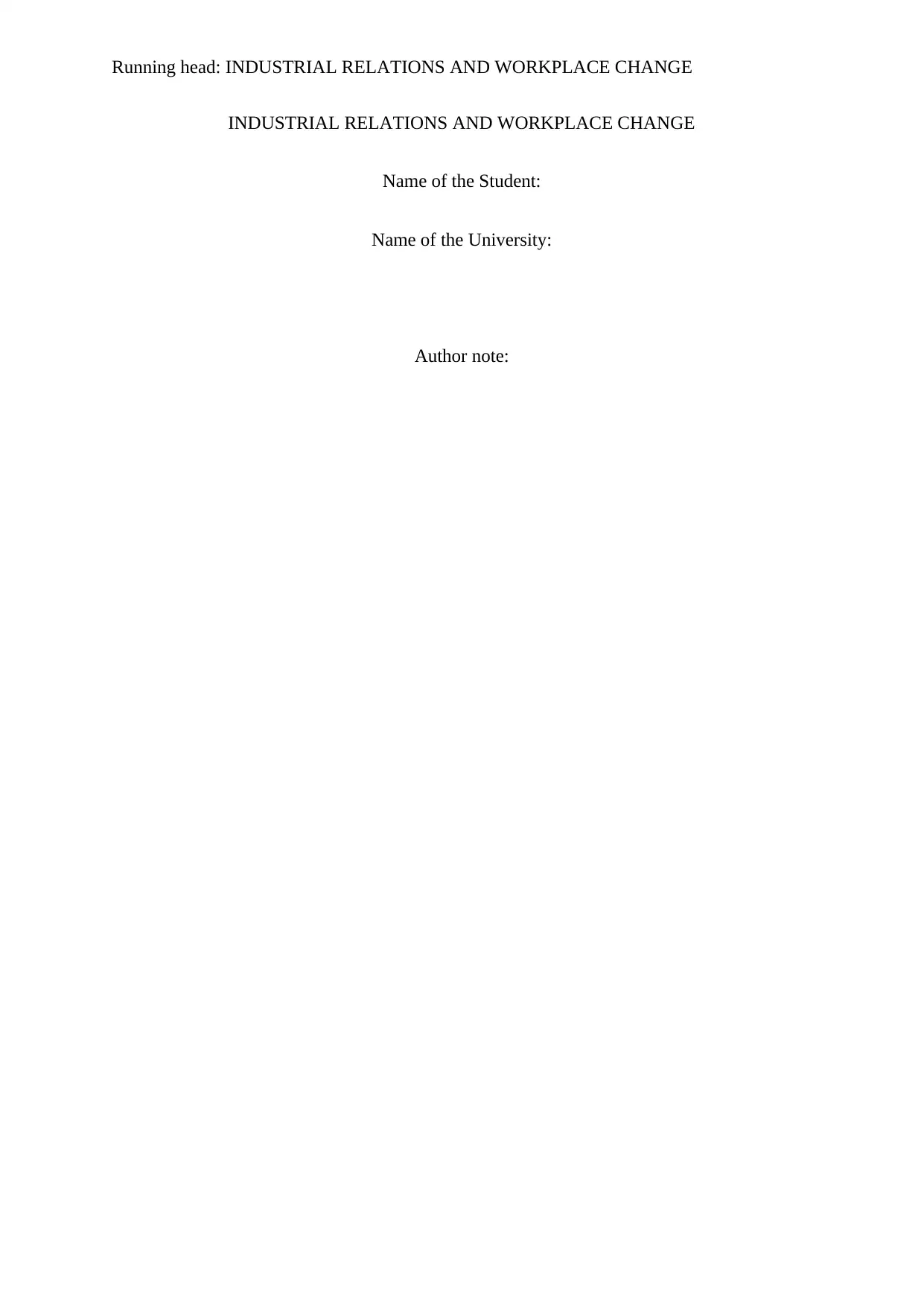
Running head: INDUSTRIAL RELATIONS AND WORKPLACE CHANGE
INDUSTRIAL RELATIONS AND WORKPLACE CHANGE
Name of the Student:
Name of the University:
Author note:
INDUSTRIAL RELATIONS AND WORKPLACE CHANGE
Name of the Student:
Name of the University:
Author note:
Paraphrase This Document
Need a fresh take? Get an instant paraphrase of this document with our AI Paraphraser
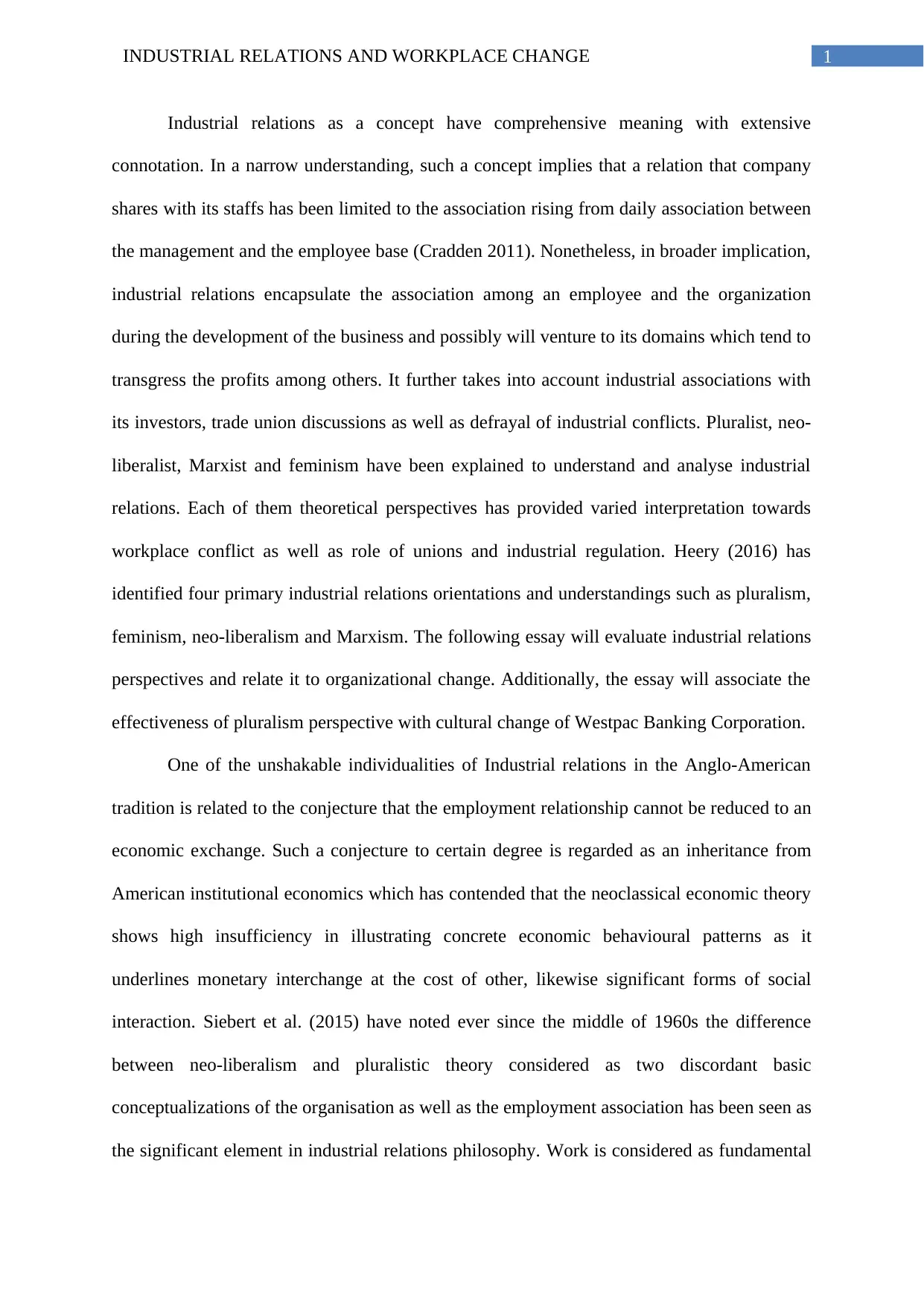
1INDUSTRIAL RELATIONS AND WORKPLACE CHANGE
Industrial relations as a concept have comprehensive meaning with extensive
connotation. In a narrow understanding, such a concept implies that a relation that company
shares with its staffs has been limited to the association rising from daily association between
the management and the employee base (Cradden 2011). Nonetheless, in broader implication,
industrial relations encapsulate the association among an employee and the organization
during the development of the business and possibly will venture to its domains which tend to
transgress the profits among others. It further takes into account industrial associations with
its investors, trade union discussions as well as defrayal of industrial conflicts. Pluralist, neo-
liberalist, Marxist and feminism have been explained to understand and analyse industrial
relations. Each of them theoretical perspectives has provided varied interpretation towards
workplace conflict as well as role of unions and industrial regulation. Heery (2016) has
identified four primary industrial relations orientations and understandings such as pluralism,
feminism, neo-liberalism and Marxism. The following essay will evaluate industrial relations
perspectives and relate it to organizational change. Additionally, the essay will associate the
effectiveness of pluralism perspective with cultural change of Westpac Banking Corporation.
One of the unshakable individualities of Industrial relations in the Anglo-American
tradition is related to the conjecture that the employment relationship cannot be reduced to an
economic exchange. Such a conjecture to certain degree is regarded as an inheritance from
American institutional economics which has contended that the neoclassical economic theory
shows high insufficiency in illustrating concrete economic behavioural patterns as it
underlines monetary interchange at the cost of other, likewise significant forms of social
interaction. Siebert et al. (2015) have noted ever since the middle of 1960s the difference
between neo-liberalism and pluralistic theory considered as two discordant basic
conceptualizations of the organisation as well as the employment association has been seen as
the significant element in industrial relations philosophy. Work is considered as fundamental
Industrial relations as a concept have comprehensive meaning with extensive
connotation. In a narrow understanding, such a concept implies that a relation that company
shares with its staffs has been limited to the association rising from daily association between
the management and the employee base (Cradden 2011). Nonetheless, in broader implication,
industrial relations encapsulate the association among an employee and the organization
during the development of the business and possibly will venture to its domains which tend to
transgress the profits among others. It further takes into account industrial associations with
its investors, trade union discussions as well as defrayal of industrial conflicts. Pluralist, neo-
liberalist, Marxist and feminism have been explained to understand and analyse industrial
relations. Each of them theoretical perspectives has provided varied interpretation towards
workplace conflict as well as role of unions and industrial regulation. Heery (2016) has
identified four primary industrial relations orientations and understandings such as pluralism,
feminism, neo-liberalism and Marxism. The following essay will evaluate industrial relations
perspectives and relate it to organizational change. Additionally, the essay will associate the
effectiveness of pluralism perspective with cultural change of Westpac Banking Corporation.
One of the unshakable individualities of Industrial relations in the Anglo-American
tradition is related to the conjecture that the employment relationship cannot be reduced to an
economic exchange. Such a conjecture to certain degree is regarded as an inheritance from
American institutional economics which has contended that the neoclassical economic theory
shows high insufficiency in illustrating concrete economic behavioural patterns as it
underlines monetary interchange at the cost of other, likewise significant forms of social
interaction. Siebert et al. (2015) have noted ever since the middle of 1960s the difference
between neo-liberalism and pluralistic theory considered as two discordant basic
conceptualizations of the organisation as well as the employment association has been seen as
the significant element in industrial relations philosophy. Work is considered as fundamental
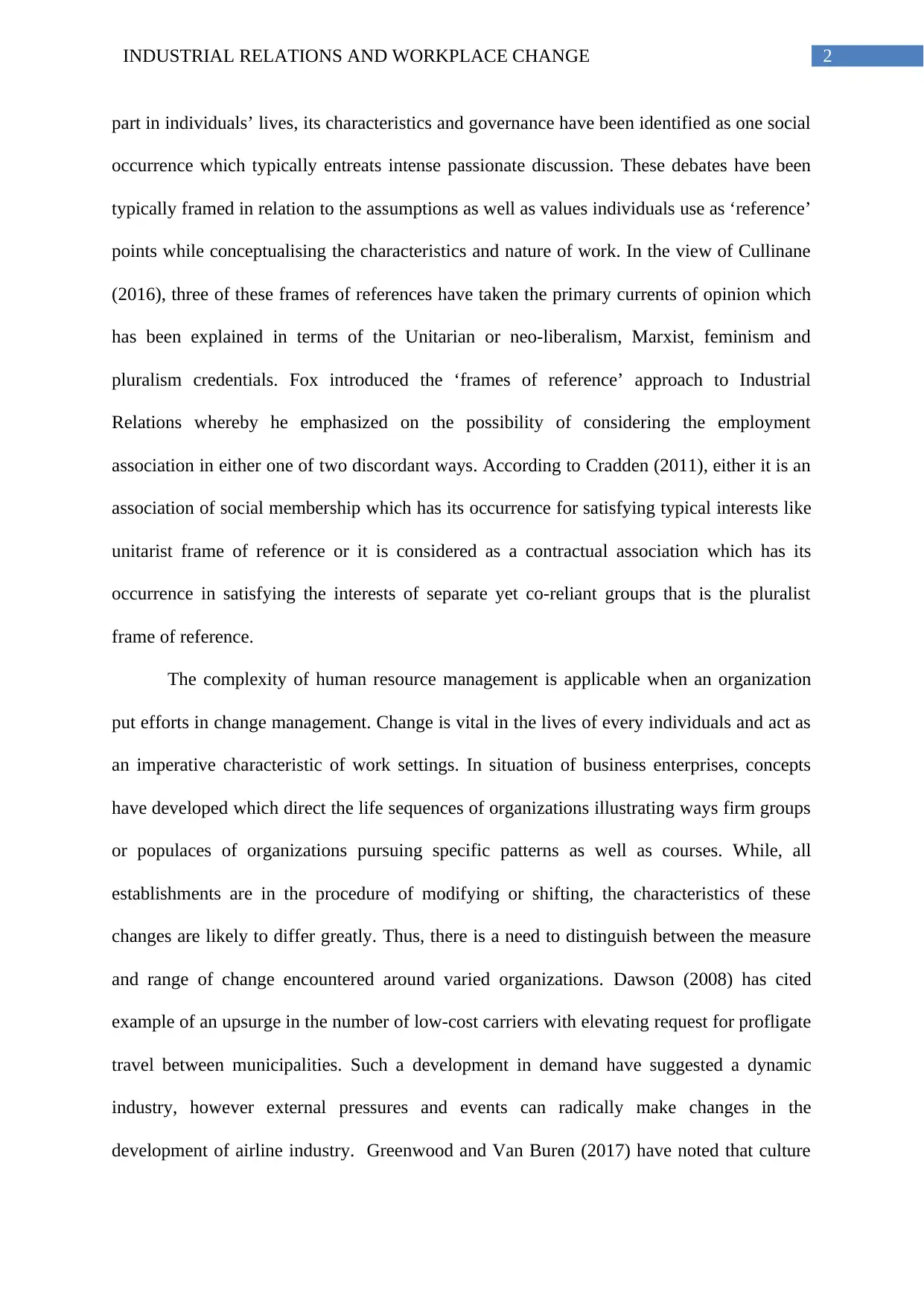
2INDUSTRIAL RELATIONS AND WORKPLACE CHANGE
part in individuals’ lives, its characteristics and governance have been identified as one social
occurrence which typically entreats intense passionate discussion. These debates have been
typically framed in relation to the assumptions as well as values individuals use as ‘reference’
points while conceptualising the characteristics and nature of work. In the view of Cullinane
(2016), three of these frames of references have taken the primary currents of opinion which
has been explained in terms of the Unitarian or neo-liberalism, Marxist, feminism and
pluralism credentials. Fox introduced the ‘frames of reference’ approach to Industrial
Relations whereby he emphasized on the possibility of considering the employment
association in either one of two discordant ways. According to Cradden (2011), either it is an
association of social membership which has its occurrence for satisfying typical interests like
unitarist frame of reference or it is considered as a contractual association which has its
occurrence in satisfying the interests of separate yet co-reliant groups that is the pluralist
frame of reference.
The complexity of human resource management is applicable when an organization
put efforts in change management. Change is vital in the lives of every individuals and act as
an imperative characteristic of work settings. In situation of business enterprises, concepts
have developed which direct the life sequences of organizations illustrating ways firm groups
or populaces of organizations pursuing specific patterns as well as courses. While, all
establishments are in the procedure of modifying or shifting, the characteristics of these
changes are likely to differ greatly. Thus, there is a need to distinguish between the measure
and range of change encountered around varied organizations. Dawson (2008) has cited
example of an upsurge in the number of low-cost carriers with elevating request for profligate
travel between municipalities. Such a development in demand have suggested a dynamic
industry, however external pressures and events can radically make changes in the
development of airline industry. Greenwood and Van Buren (2017) have noted that culture
part in individuals’ lives, its characteristics and governance have been identified as one social
occurrence which typically entreats intense passionate discussion. These debates have been
typically framed in relation to the assumptions as well as values individuals use as ‘reference’
points while conceptualising the characteristics and nature of work. In the view of Cullinane
(2016), three of these frames of references have taken the primary currents of opinion which
has been explained in terms of the Unitarian or neo-liberalism, Marxist, feminism and
pluralism credentials. Fox introduced the ‘frames of reference’ approach to Industrial
Relations whereby he emphasized on the possibility of considering the employment
association in either one of two discordant ways. According to Cradden (2011), either it is an
association of social membership which has its occurrence for satisfying typical interests like
unitarist frame of reference or it is considered as a contractual association which has its
occurrence in satisfying the interests of separate yet co-reliant groups that is the pluralist
frame of reference.
The complexity of human resource management is applicable when an organization
put efforts in change management. Change is vital in the lives of every individuals and act as
an imperative characteristic of work settings. In situation of business enterprises, concepts
have developed which direct the life sequences of organizations illustrating ways firm groups
or populaces of organizations pursuing specific patterns as well as courses. While, all
establishments are in the procedure of modifying or shifting, the characteristics of these
changes are likely to differ greatly. Thus, there is a need to distinguish between the measure
and range of change encountered around varied organizations. Dawson (2008) has cited
example of an upsurge in the number of low-cost carriers with elevating request for profligate
travel between municipalities. Such a development in demand have suggested a dynamic
industry, however external pressures and events can radically make changes in the
development of airline industry. Greenwood and Van Buren (2017) have noted that culture
⊘ This is a preview!⊘
Do you want full access?
Subscribe today to unlock all pages.

Trusted by 1+ million students worldwide
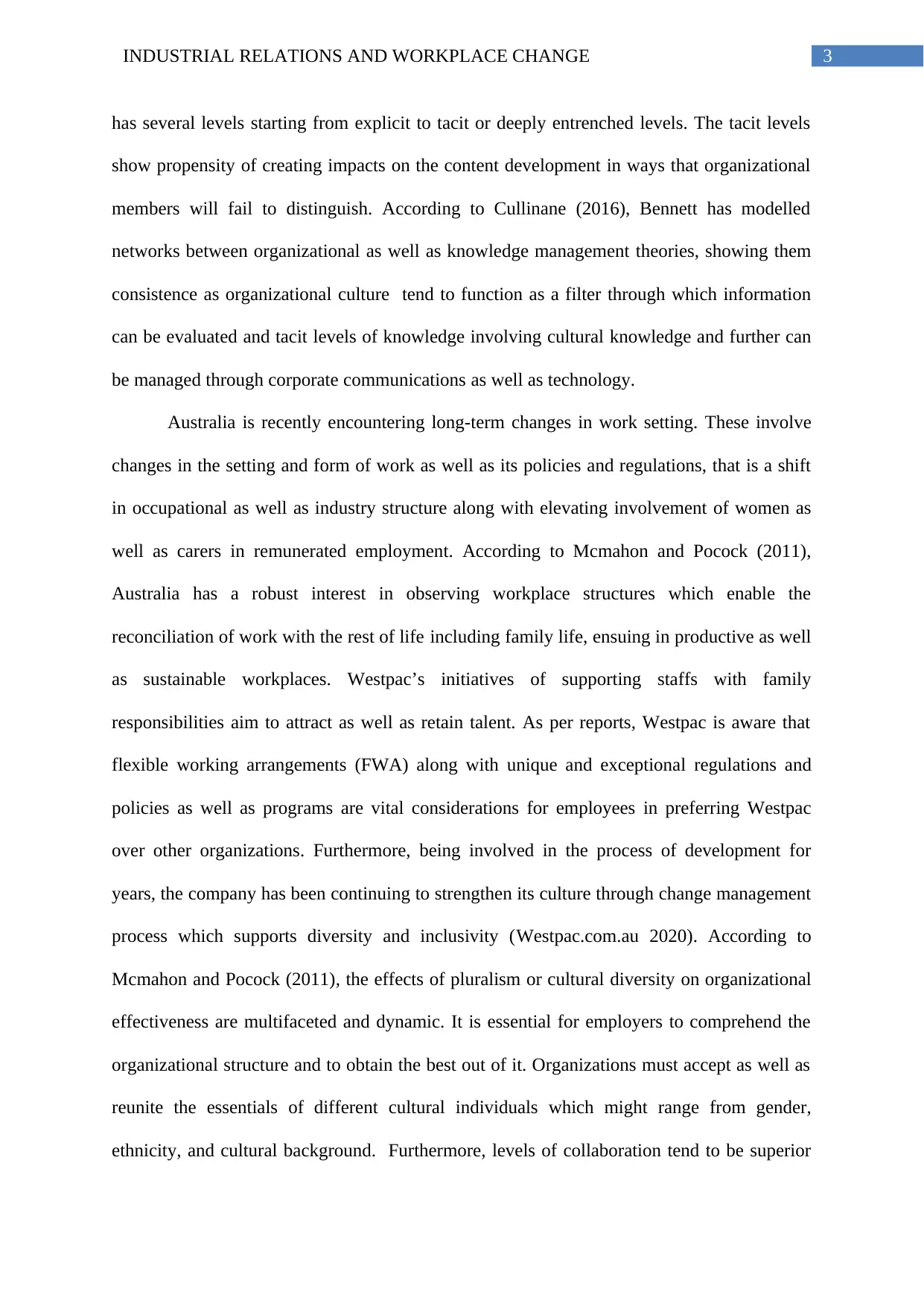
3INDUSTRIAL RELATIONS AND WORKPLACE CHANGE
has several levels starting from explicit to tacit or deeply entrenched levels. The tacit levels
show propensity of creating impacts on the content development in ways that organizational
members will fail to distinguish. According to Cullinane (2016), Bennett has modelled
networks between organizational as well as knowledge management theories, showing them
consistence as organizational culture tend to function as a filter through which information
can be evaluated and tacit levels of knowledge involving cultural knowledge and further can
be managed through corporate communications as well as technology.
Australia is recently encountering long-term changes in work setting. These involve
changes in the setting and form of work as well as its policies and regulations, that is a shift
in occupational as well as industry structure along with elevating involvement of women as
well as carers in remunerated employment. According to Mcmahon and Pocock (2011),
Australia has a robust interest in observing workplace structures which enable the
reconciliation of work with the rest of life including family life, ensuing in productive as well
as sustainable workplaces. Westpac’s initiatives of supporting staffs with family
responsibilities aim to attract as well as retain talent. As per reports, Westpac is aware that
flexible working arrangements (FWA) along with unique and exceptional regulations and
policies as well as programs are vital considerations for employees in preferring Westpac
over other organizations. Furthermore, being involved in the process of development for
years, the company has been continuing to strengthen its culture through change management
process which supports diversity and inclusivity (Westpac.com.au 2020). According to
Mcmahon and Pocock (2011), the effects of pluralism or cultural diversity on organizational
effectiveness are multifaceted and dynamic. It is essential for employers to comprehend the
organizational structure and to obtain the best out of it. Organizations must accept as well as
reunite the essentials of different cultural individuals which might range from gender,
ethnicity, and cultural background. Furthermore, levels of collaboration tend to be superior
has several levels starting from explicit to tacit or deeply entrenched levels. The tacit levels
show propensity of creating impacts on the content development in ways that organizational
members will fail to distinguish. According to Cullinane (2016), Bennett has modelled
networks between organizational as well as knowledge management theories, showing them
consistence as organizational culture tend to function as a filter through which information
can be evaluated and tacit levels of knowledge involving cultural knowledge and further can
be managed through corporate communications as well as technology.
Australia is recently encountering long-term changes in work setting. These involve
changes in the setting and form of work as well as its policies and regulations, that is a shift
in occupational as well as industry structure along with elevating involvement of women as
well as carers in remunerated employment. According to Mcmahon and Pocock (2011),
Australia has a robust interest in observing workplace structures which enable the
reconciliation of work with the rest of life including family life, ensuing in productive as well
as sustainable workplaces. Westpac’s initiatives of supporting staffs with family
responsibilities aim to attract as well as retain talent. As per reports, Westpac is aware that
flexible working arrangements (FWA) along with unique and exceptional regulations and
policies as well as programs are vital considerations for employees in preferring Westpac
over other organizations. Furthermore, being involved in the process of development for
years, the company has been continuing to strengthen its culture through change management
process which supports diversity and inclusivity (Westpac.com.au 2020). According to
Mcmahon and Pocock (2011), the effects of pluralism or cultural diversity on organizational
effectiveness are multifaceted and dynamic. It is essential for employers to comprehend the
organizational structure and to obtain the best out of it. Organizations must accept as well as
reunite the essentials of different cultural individuals which might range from gender,
ethnicity, and cultural background. Furthermore, levels of collaboration tend to be superior
Paraphrase This Document
Need a fresh take? Get an instant paraphrase of this document with our AI Paraphraser
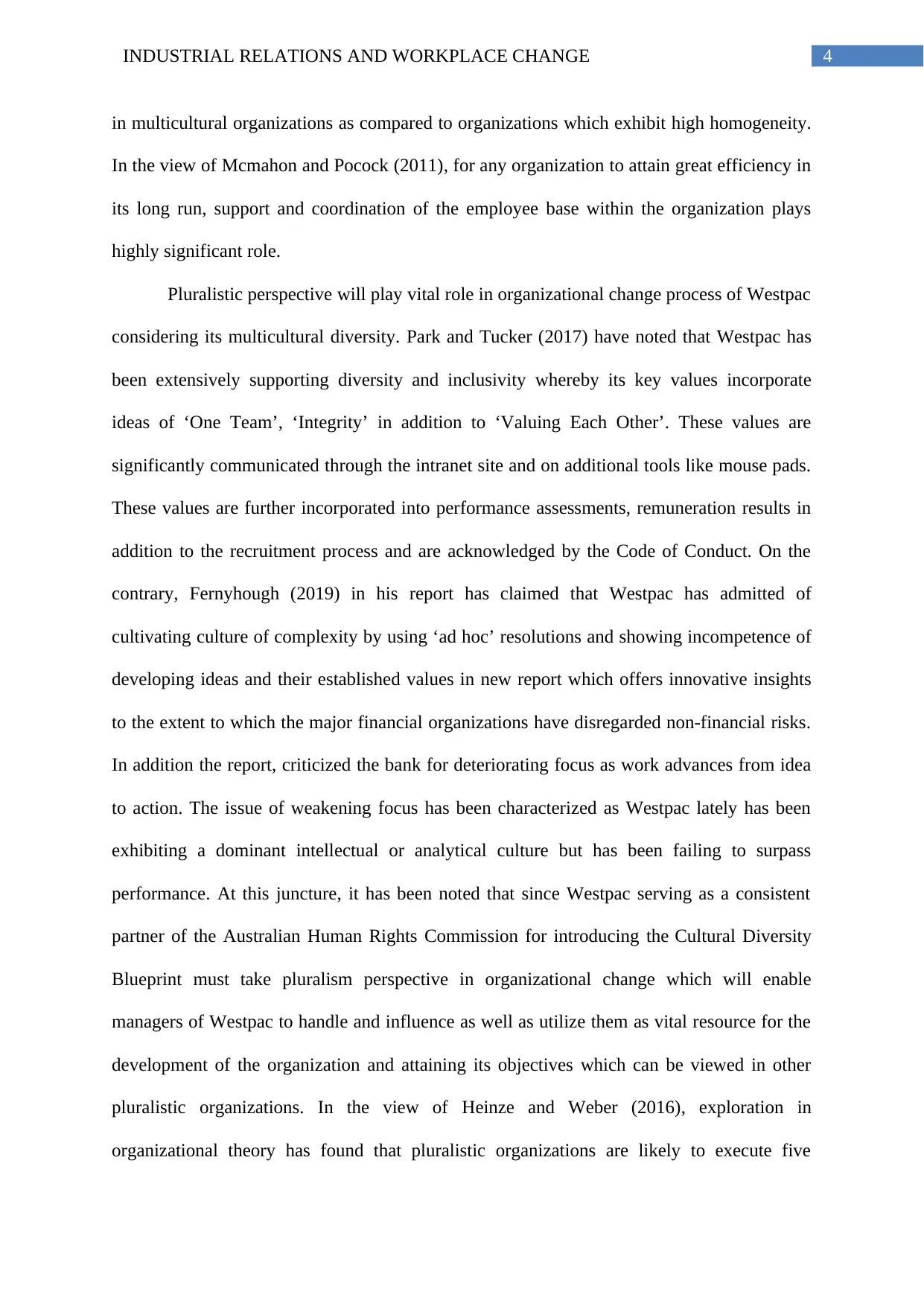
4INDUSTRIAL RELATIONS AND WORKPLACE CHANGE
in multicultural organizations as compared to organizations which exhibit high homogeneity.
In the view of Mcmahon and Pocock (2011), for any organization to attain great efficiency in
its long run, support and coordination of the employee base within the organization plays
highly significant role.
Pluralistic perspective will play vital role in organizational change process of Westpac
considering its multicultural diversity. Park and Tucker (2017) have noted that Westpac has
been extensively supporting diversity and inclusivity whereby its key values incorporate
ideas of ‘One Team’, ‘Integrity’ in addition to ‘Valuing Each Other’. These values are
significantly communicated through the intranet site and on additional tools like mouse pads.
These values are further incorporated into performance assessments, remuneration results in
addition to the recruitment process and are acknowledged by the Code of Conduct. On the
contrary, Fernyhough (2019) in his report has claimed that Westpac has admitted of
cultivating culture of complexity by using ‘ad hoc’ resolutions and showing incompetence of
developing ideas and their established values in new report which offers innovative insights
to the extent to which the major financial organizations have disregarded non-financial risks.
In addition the report, criticized the bank for deteriorating focus as work advances from idea
to action. The issue of weakening focus has been characterized as Westpac lately has been
exhibiting a dominant intellectual or analytical culture but has been failing to surpass
performance. At this juncture, it has been noted that since Westpac serving as a consistent
partner of the Australian Human Rights Commission for introducing the Cultural Diversity
Blueprint must take pluralism perspective in organizational change which will enable
managers of Westpac to handle and influence as well as utilize them as vital resource for the
development of the organization and attaining its objectives which can be viewed in other
pluralistic organizations. In the view of Heinze and Weber (2016), exploration in
organizational theory has found that pluralistic organizations are likely to execute five
in multicultural organizations as compared to organizations which exhibit high homogeneity.
In the view of Mcmahon and Pocock (2011), for any organization to attain great efficiency in
its long run, support and coordination of the employee base within the organization plays
highly significant role.
Pluralistic perspective will play vital role in organizational change process of Westpac
considering its multicultural diversity. Park and Tucker (2017) have noted that Westpac has
been extensively supporting diversity and inclusivity whereby its key values incorporate
ideas of ‘One Team’, ‘Integrity’ in addition to ‘Valuing Each Other’. These values are
significantly communicated through the intranet site and on additional tools like mouse pads.
These values are further incorporated into performance assessments, remuneration results in
addition to the recruitment process and are acknowledged by the Code of Conduct. On the
contrary, Fernyhough (2019) in his report has claimed that Westpac has admitted of
cultivating culture of complexity by using ‘ad hoc’ resolutions and showing incompetence of
developing ideas and their established values in new report which offers innovative insights
to the extent to which the major financial organizations have disregarded non-financial risks.
In addition the report, criticized the bank for deteriorating focus as work advances from idea
to action. The issue of weakening focus has been characterized as Westpac lately has been
exhibiting a dominant intellectual or analytical culture but has been failing to surpass
performance. At this juncture, it has been noted that since Westpac serving as a consistent
partner of the Australian Human Rights Commission for introducing the Cultural Diversity
Blueprint must take pluralism perspective in organizational change which will enable
managers of Westpac to handle and influence as well as utilize them as vital resource for the
development of the organization and attaining its objectives which can be viewed in other
pluralistic organizations. In the view of Heinze and Weber (2016), exploration in
organizational theory has found that pluralistic organizations are likely to execute five
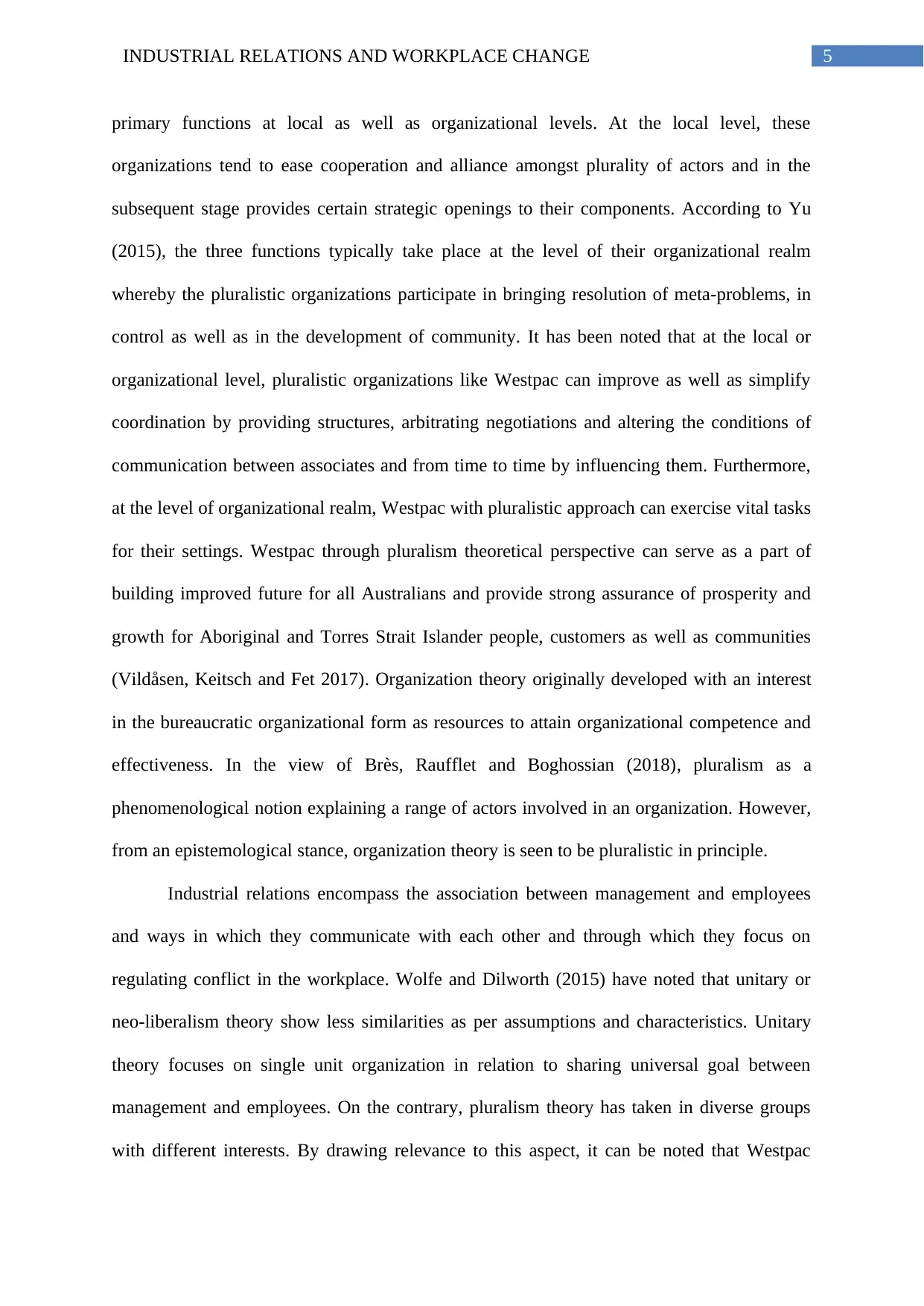
5INDUSTRIAL RELATIONS AND WORKPLACE CHANGE
primary functions at local as well as organizational levels. At the local level, these
organizations tend to ease cooperation and alliance amongst plurality of actors and in the
subsequent stage provides certain strategic openings to their components. According to Yu
(2015), the three functions typically take place at the level of their organizational realm
whereby the pluralistic organizations participate in bringing resolution of meta-problems, in
control as well as in the development of community. It has been noted that at the local or
organizational level, pluralistic organizations like Westpac can improve as well as simplify
coordination by providing structures, arbitrating negotiations and altering the conditions of
communication between associates and from time to time by influencing them. Furthermore,
at the level of organizational realm, Westpac with pluralistic approach can exercise vital tasks
for their settings. Westpac through pluralism theoretical perspective can serve as a part of
building improved future for all Australians and provide strong assurance of prosperity and
growth for Aboriginal and Torres Strait Islander people, customers as well as communities
(Vildåsen, Keitsch and Fet 2017). Organization theory originally developed with an interest
in the bureaucratic organizational form as resources to attain organizational competence and
effectiveness. In the view of Brès, Raufflet and Boghossian (2018), pluralism as a
phenomenological notion explaining a range of actors involved in an organization. However,
from an epistemological stance, organization theory is seen to be pluralistic in principle.
Industrial relations encompass the association between management and employees
and ways in which they communicate with each other and through which they focus on
regulating conflict in the workplace. Wolfe and Dilworth (2015) have noted that unitary or
neo-liberalism theory show less similarities as per assumptions and characteristics. Unitary
theory focuses on single unit organization in relation to sharing universal goal between
management and employees. On the contrary, pluralism theory has taken in diverse groups
with different interests. By drawing relevance to this aspect, it can be noted that Westpac
primary functions at local as well as organizational levels. At the local level, these
organizations tend to ease cooperation and alliance amongst plurality of actors and in the
subsequent stage provides certain strategic openings to their components. According to Yu
(2015), the three functions typically take place at the level of their organizational realm
whereby the pluralistic organizations participate in bringing resolution of meta-problems, in
control as well as in the development of community. It has been noted that at the local or
organizational level, pluralistic organizations like Westpac can improve as well as simplify
coordination by providing structures, arbitrating negotiations and altering the conditions of
communication between associates and from time to time by influencing them. Furthermore,
at the level of organizational realm, Westpac with pluralistic approach can exercise vital tasks
for their settings. Westpac through pluralism theoretical perspective can serve as a part of
building improved future for all Australians and provide strong assurance of prosperity and
growth for Aboriginal and Torres Strait Islander people, customers as well as communities
(Vildåsen, Keitsch and Fet 2017). Organization theory originally developed with an interest
in the bureaucratic organizational form as resources to attain organizational competence and
effectiveness. In the view of Brès, Raufflet and Boghossian (2018), pluralism as a
phenomenological notion explaining a range of actors involved in an organization. However,
from an epistemological stance, organization theory is seen to be pluralistic in principle.
Industrial relations encompass the association between management and employees
and ways in which they communicate with each other and through which they focus on
regulating conflict in the workplace. Wolfe and Dilworth (2015) have noted that unitary or
neo-liberalism theory show less similarities as per assumptions and characteristics. Unitary
theory focuses on single unit organization in relation to sharing universal goal between
management and employees. On the contrary, pluralism theory has taken in diverse groups
with different interests. By drawing relevance to this aspect, it can be noted that Westpac
⊘ This is a preview!⊘
Do you want full access?
Subscribe today to unlock all pages.

Trusted by 1+ million students worldwide
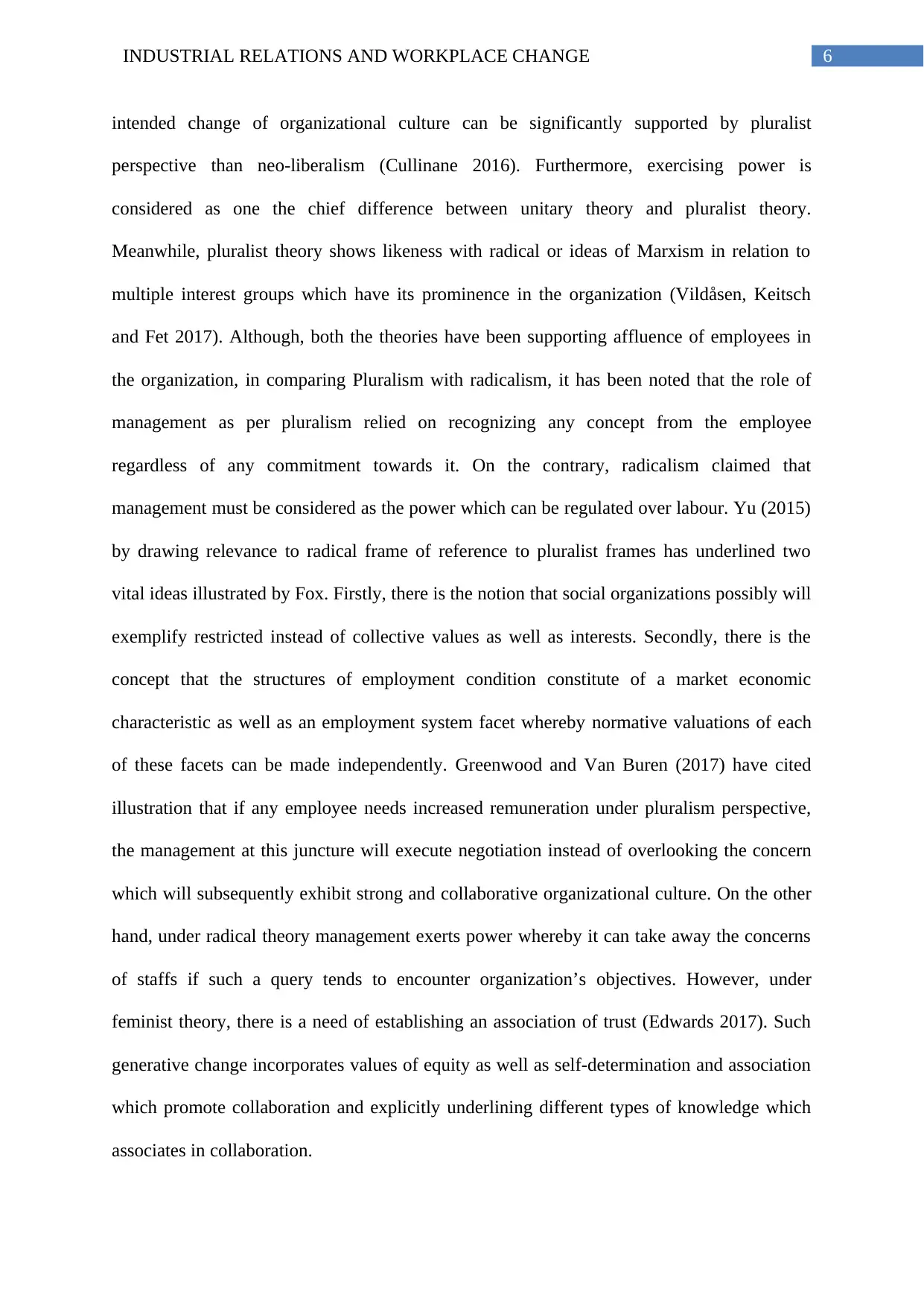
6INDUSTRIAL RELATIONS AND WORKPLACE CHANGE
intended change of organizational culture can be significantly supported by pluralist
perspective than neo-liberalism (Cullinane 2016). Furthermore, exercising power is
considered as one the chief difference between unitary theory and pluralist theory.
Meanwhile, pluralist theory shows likeness with radical or ideas of Marxism in relation to
multiple interest groups which have its prominence in the organization (Vildåsen, Keitsch
and Fet 2017). Although, both the theories have been supporting affluence of employees in
the organization, in comparing Pluralism with radicalism, it has been noted that the role of
management as per pluralism relied on recognizing any concept from the employee
regardless of any commitment towards it. On the contrary, radicalism claimed that
management must be considered as the power which can be regulated over labour. Yu (2015)
by drawing relevance to radical frame of reference to pluralist frames has underlined two
vital ideas illustrated by Fox. Firstly, there is the notion that social organizations possibly will
exemplify restricted instead of collective values as well as interests. Secondly, there is the
concept that the structures of employment condition constitute of a market economic
characteristic as well as an employment system facet whereby normative valuations of each
of these facets can be made independently. Greenwood and Van Buren (2017) have cited
illustration that if any employee needs increased remuneration under pluralism perspective,
the management at this juncture will execute negotiation instead of overlooking the concern
which will subsequently exhibit strong and collaborative organizational culture. On the other
hand, under radical theory management exerts power whereby it can take away the concerns
of staffs if such a query tends to encounter organization’s objectives. However, under
feminist theory, there is a need of establishing an association of trust (Edwards 2017). Such
generative change incorporates values of equity as well as self-determination and association
which promote collaboration and explicitly underlining different types of knowledge which
associates in collaboration.
intended change of organizational culture can be significantly supported by pluralist
perspective than neo-liberalism (Cullinane 2016). Furthermore, exercising power is
considered as one the chief difference between unitary theory and pluralist theory.
Meanwhile, pluralist theory shows likeness with radical or ideas of Marxism in relation to
multiple interest groups which have its prominence in the organization (Vildåsen, Keitsch
and Fet 2017). Although, both the theories have been supporting affluence of employees in
the organization, in comparing Pluralism with radicalism, it has been noted that the role of
management as per pluralism relied on recognizing any concept from the employee
regardless of any commitment towards it. On the contrary, radicalism claimed that
management must be considered as the power which can be regulated over labour. Yu (2015)
by drawing relevance to radical frame of reference to pluralist frames has underlined two
vital ideas illustrated by Fox. Firstly, there is the notion that social organizations possibly will
exemplify restricted instead of collective values as well as interests. Secondly, there is the
concept that the structures of employment condition constitute of a market economic
characteristic as well as an employment system facet whereby normative valuations of each
of these facets can be made independently. Greenwood and Van Buren (2017) have cited
illustration that if any employee needs increased remuneration under pluralism perspective,
the management at this juncture will execute negotiation instead of overlooking the concern
which will subsequently exhibit strong and collaborative organizational culture. On the other
hand, under radical theory management exerts power whereby it can take away the concerns
of staffs if such a query tends to encounter organization’s objectives. However, under
feminist theory, there is a need of establishing an association of trust (Edwards 2017). Such
generative change incorporates values of equity as well as self-determination and association
which promote collaboration and explicitly underlining different types of knowledge which
associates in collaboration.
Paraphrase This Document
Need a fresh take? Get an instant paraphrase of this document with our AI Paraphraser
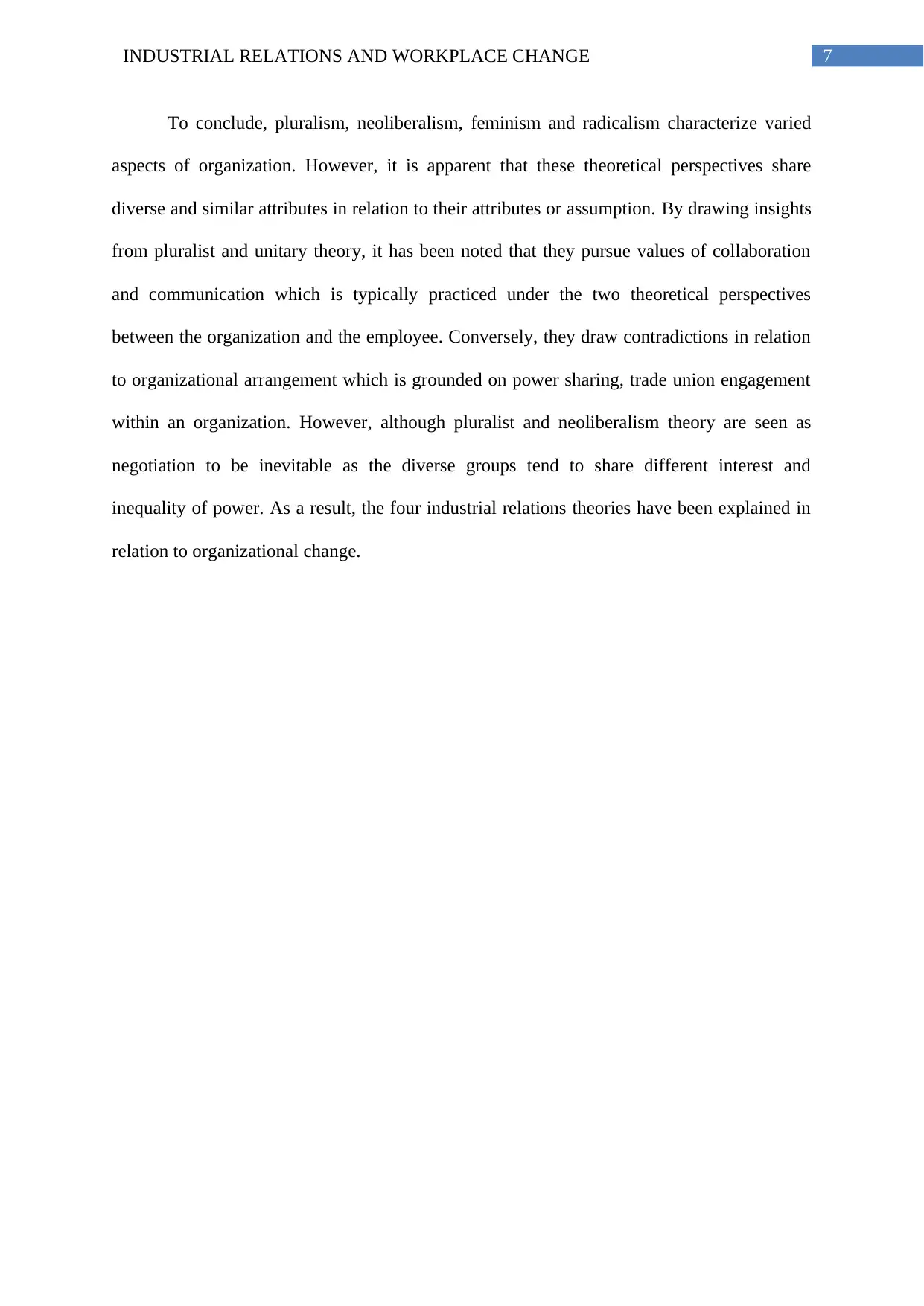
7INDUSTRIAL RELATIONS AND WORKPLACE CHANGE
To conclude, pluralism, neoliberalism, feminism and radicalism characterize varied
aspects of organization. However, it is apparent that these theoretical perspectives share
diverse and similar attributes in relation to their attributes or assumption. By drawing insights
from pluralist and unitary theory, it has been noted that they pursue values of collaboration
and communication which is typically practiced under the two theoretical perspectives
between the organization and the employee. Conversely, they draw contradictions in relation
to organizational arrangement which is grounded on power sharing, trade union engagement
within an organization. However, although pluralist and neoliberalism theory are seen as
negotiation to be inevitable as the diverse groups tend to share different interest and
inequality of power. As a result, the four industrial relations theories have been explained in
relation to organizational change.
To conclude, pluralism, neoliberalism, feminism and radicalism characterize varied
aspects of organization. However, it is apparent that these theoretical perspectives share
diverse and similar attributes in relation to their attributes or assumption. By drawing insights
from pluralist and unitary theory, it has been noted that they pursue values of collaboration
and communication which is typically practiced under the two theoretical perspectives
between the organization and the employee. Conversely, they draw contradictions in relation
to organizational arrangement which is grounded on power sharing, trade union engagement
within an organization. However, although pluralist and neoliberalism theory are seen as
negotiation to be inevitable as the diverse groups tend to share different interest and
inequality of power. As a result, the four industrial relations theories have been explained in
relation to organizational change.
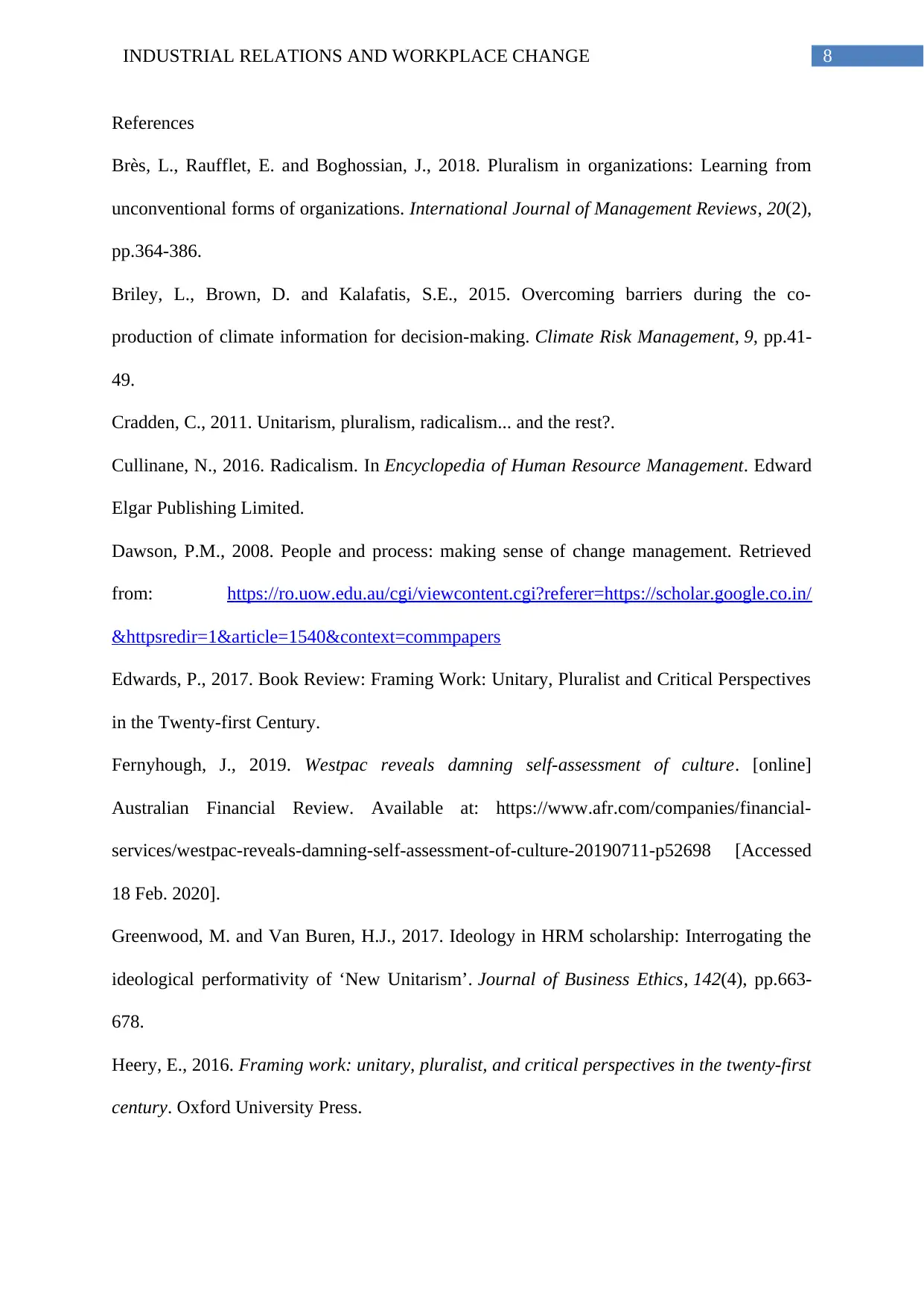
8INDUSTRIAL RELATIONS AND WORKPLACE CHANGE
References
Brès, L., Raufflet, E. and Boghossian, J., 2018. Pluralism in organizations: Learning from
unconventional forms of organizations. International Journal of Management Reviews, 20(2),
pp.364-386.
Briley, L., Brown, D. and Kalafatis, S.E., 2015. Overcoming barriers during the co-
production of climate information for decision-making. Climate Risk Management, 9, pp.41-
49.
Cradden, C., 2011. Unitarism, pluralism, radicalism... and the rest?.
Cullinane, N., 2016. Radicalism. In Encyclopedia of Human Resource Management. Edward
Elgar Publishing Limited.
Dawson, P.M., 2008. People and process: making sense of change management. Retrieved
from: https://ro.uow.edu.au/cgi/viewcontent.cgi?referer=https://scholar.google.co.in/
&httpsredir=1&article=1540&context=commpapers
Edwards, P., 2017. Book Review: Framing Work: Unitary, Pluralist and Critical Perspectives
in the Twenty-first Century.
Fernyhough, J., 2019. Westpac reveals damning self-assessment of culture. [online]
Australian Financial Review. Available at: https://www.afr.com/companies/financial-
services/westpac-reveals-damning-self-assessment-of-culture-20190711-p52698 [Accessed
18 Feb. 2020].
Greenwood, M. and Van Buren, H.J., 2017. Ideology in HRM scholarship: Interrogating the
ideological performativity of ‘New Unitarism’. Journal of Business Ethics, 142(4), pp.663-
678.
Heery, E., 2016. Framing work: unitary, pluralist, and critical perspectives in the twenty-first
century. Oxford University Press.
References
Brès, L., Raufflet, E. and Boghossian, J., 2018. Pluralism in organizations: Learning from
unconventional forms of organizations. International Journal of Management Reviews, 20(2),
pp.364-386.
Briley, L., Brown, D. and Kalafatis, S.E., 2015. Overcoming barriers during the co-
production of climate information for decision-making. Climate Risk Management, 9, pp.41-
49.
Cradden, C., 2011. Unitarism, pluralism, radicalism... and the rest?.
Cullinane, N., 2016. Radicalism. In Encyclopedia of Human Resource Management. Edward
Elgar Publishing Limited.
Dawson, P.M., 2008. People and process: making sense of change management. Retrieved
from: https://ro.uow.edu.au/cgi/viewcontent.cgi?referer=https://scholar.google.co.in/
&httpsredir=1&article=1540&context=commpapers
Edwards, P., 2017. Book Review: Framing Work: Unitary, Pluralist and Critical Perspectives
in the Twenty-first Century.
Fernyhough, J., 2019. Westpac reveals damning self-assessment of culture. [online]
Australian Financial Review. Available at: https://www.afr.com/companies/financial-
services/westpac-reveals-damning-self-assessment-of-culture-20190711-p52698 [Accessed
18 Feb. 2020].
Greenwood, M. and Van Buren, H.J., 2017. Ideology in HRM scholarship: Interrogating the
ideological performativity of ‘New Unitarism’. Journal of Business Ethics, 142(4), pp.663-
678.
Heery, E., 2016. Framing work: unitary, pluralist, and critical perspectives in the twenty-first
century. Oxford University Press.
⊘ This is a preview!⊘
Do you want full access?
Subscribe today to unlock all pages.

Trusted by 1+ million students worldwide
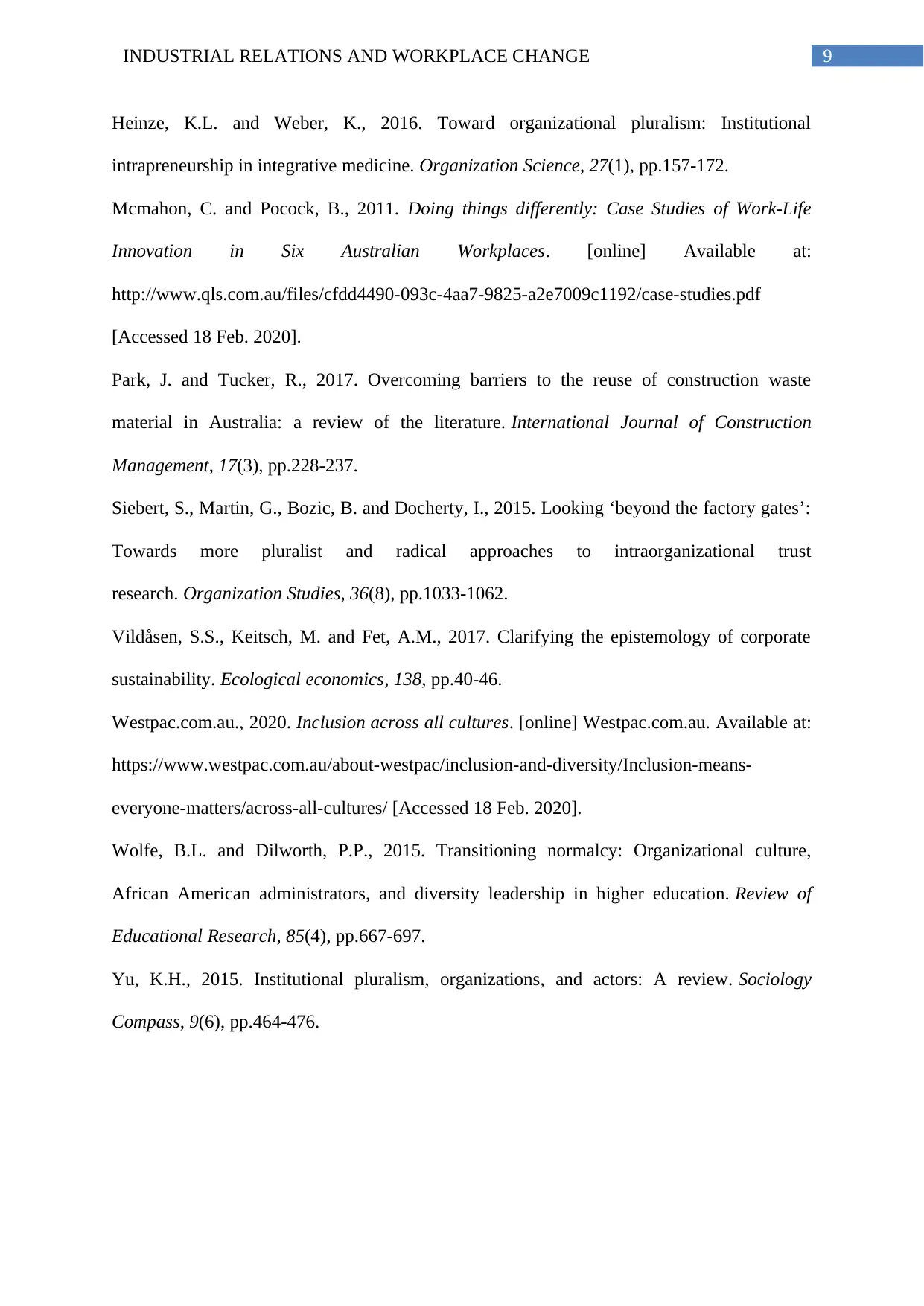
9INDUSTRIAL RELATIONS AND WORKPLACE CHANGE
Heinze, K.L. and Weber, K., 2016. Toward organizational pluralism: Institutional
intrapreneurship in integrative medicine. Organization Science, 27(1), pp.157-172.
Mcmahon, C. and Pocock, B., 2011. Doing things differently: Case Studies of Work-Life
Innovation in Six Australian Workplaces. [online] Available at:
http://www.qls.com.au/files/cfdd4490-093c-4aa7-9825-a2e7009c1192/case-studies.pdf
[Accessed 18 Feb. 2020].
Park, J. and Tucker, R., 2017. Overcoming barriers to the reuse of construction waste
material in Australia: a review of the literature. International Journal of Construction
Management, 17(3), pp.228-237.
Siebert, S., Martin, G., Bozic, B. and Docherty, I., 2015. Looking ‘beyond the factory gates’:
Towards more pluralist and radical approaches to intraorganizational trust
research. Organization Studies, 36(8), pp.1033-1062.
Vildåsen, S.S., Keitsch, M. and Fet, A.M., 2017. Clarifying the epistemology of corporate
sustainability. Ecological economics, 138, pp.40-46.
Westpac.com.au., 2020. Inclusion across all cultures. [online] Westpac.com.au. Available at:
https://www.westpac.com.au/about-westpac/inclusion-and-diversity/Inclusion-means-
everyone-matters/across-all-cultures/ [Accessed 18 Feb. 2020].
Wolfe, B.L. and Dilworth, P.P., 2015. Transitioning normalcy: Organizational culture,
African American administrators, and diversity leadership in higher education. Review of
Educational Research, 85(4), pp.667-697.
Yu, K.H., 2015. Institutional pluralism, organizations, and actors: A review. Sociology
Compass, 9(6), pp.464-476.
Heinze, K.L. and Weber, K., 2016. Toward organizational pluralism: Institutional
intrapreneurship in integrative medicine. Organization Science, 27(1), pp.157-172.
Mcmahon, C. and Pocock, B., 2011. Doing things differently: Case Studies of Work-Life
Innovation in Six Australian Workplaces. [online] Available at:
http://www.qls.com.au/files/cfdd4490-093c-4aa7-9825-a2e7009c1192/case-studies.pdf
[Accessed 18 Feb. 2020].
Park, J. and Tucker, R., 2017. Overcoming barriers to the reuse of construction waste
material in Australia: a review of the literature. International Journal of Construction
Management, 17(3), pp.228-237.
Siebert, S., Martin, G., Bozic, B. and Docherty, I., 2015. Looking ‘beyond the factory gates’:
Towards more pluralist and radical approaches to intraorganizational trust
research. Organization Studies, 36(8), pp.1033-1062.
Vildåsen, S.S., Keitsch, M. and Fet, A.M., 2017. Clarifying the epistemology of corporate
sustainability. Ecological economics, 138, pp.40-46.
Westpac.com.au., 2020. Inclusion across all cultures. [online] Westpac.com.au. Available at:
https://www.westpac.com.au/about-westpac/inclusion-and-diversity/Inclusion-means-
everyone-matters/across-all-cultures/ [Accessed 18 Feb. 2020].
Wolfe, B.L. and Dilworth, P.P., 2015. Transitioning normalcy: Organizational culture,
African American administrators, and diversity leadership in higher education. Review of
Educational Research, 85(4), pp.667-697.
Yu, K.H., 2015. Institutional pluralism, organizations, and actors: A review. Sociology
Compass, 9(6), pp.464-476.
1 out of 10
Related Documents
Your All-in-One AI-Powered Toolkit for Academic Success.
+13062052269
info@desklib.com
Available 24*7 on WhatsApp / Email
![[object Object]](/_next/static/media/star-bottom.7253800d.svg)
Unlock your academic potential
Copyright © 2020–2025 A2Z Services. All Rights Reserved. Developed and managed by ZUCOL.





